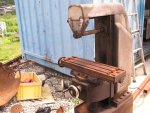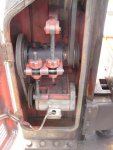it’s how my mind works. I’d be banging my head if I had to make even a semi-tough part on a horizontal.

That I can certainly understand, but if you think about it, the only difference is that the cutter is turned on it's side. If you turn the work on it's side, you can a similar cut.
This about this cut. A guy that helped me with the fixture for my little mini-mill used a rougher 3 1/8" long end mill that he used to true the ends of a piece of 3" x 3" aluminum...In some cases to do similar. But you could also use a wide cutter on a horizontal to do the same process to the lengths easily, if that makes sense. Where on a vertical mill you would most likely use a fly cutter.
Put the same fly cutter on a collet in the horizontal mill and you can not fly cut the ends of stock. With a basic mill vise, you can accomplish both tasks by using the other tool (i.e., fly cutter vs rougher).
I haven't used the mill yet so really don't have any experience using a horizontal mill. It's a very cool machine though, well built, and post war, but pre 60s. I prefer pre-60s type machines.
Horizontal mills were more common at one point in time. So, in some ways the vertical head in how technology advanced, and it seems more suitable for CNC...You can probably do a lot more on your vertical mill than I can on my horizontal mill, since it's all about tooling and clamping...and I suspect seeing your big 'ol rotary table, you've probably got me beat in the tooling area by a long shot...
My mill has the No. 40 taper, and the same taper is used on Haas CNCs, so that's convenient for used tools. I haven't gotten any yet, still putting humpty together again...
For slotting, it's more difficult to slot, actually, although it does work. I can do it on my little mini-mill, as I could a Bridgeport, using the exact same arbor, saw, and fixture. It works. The Nichols is much better suited for that operation, though.









 after about the 5th setup with a horizontal.
after about the 5th setup with a horizontal.






